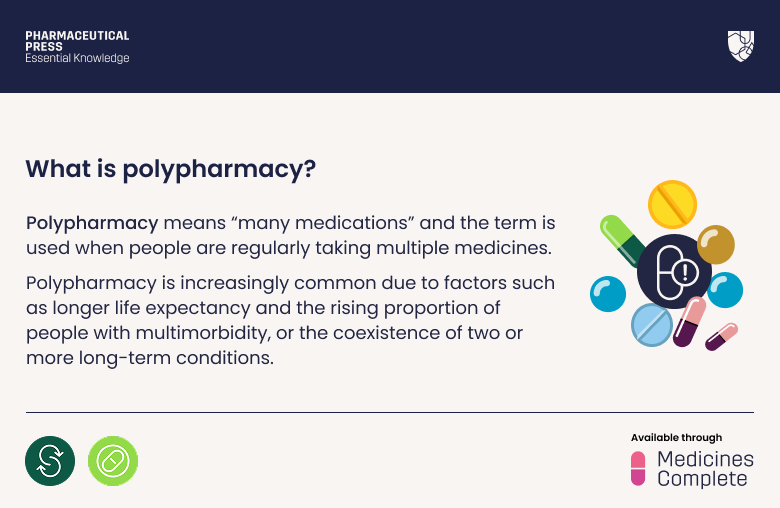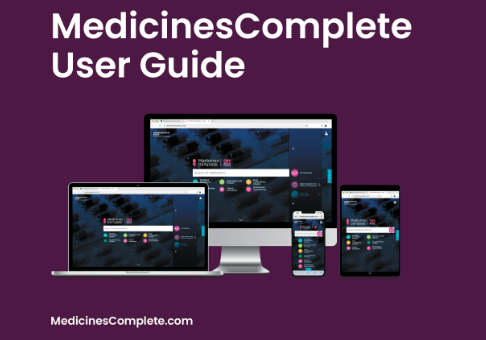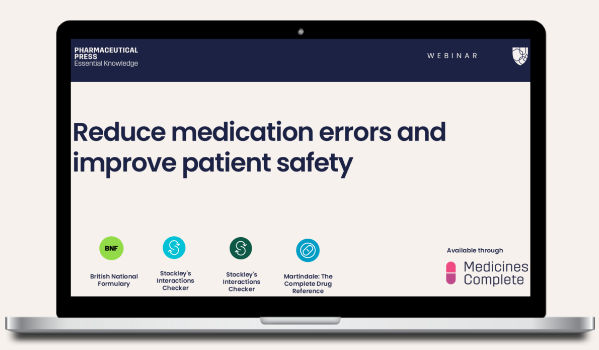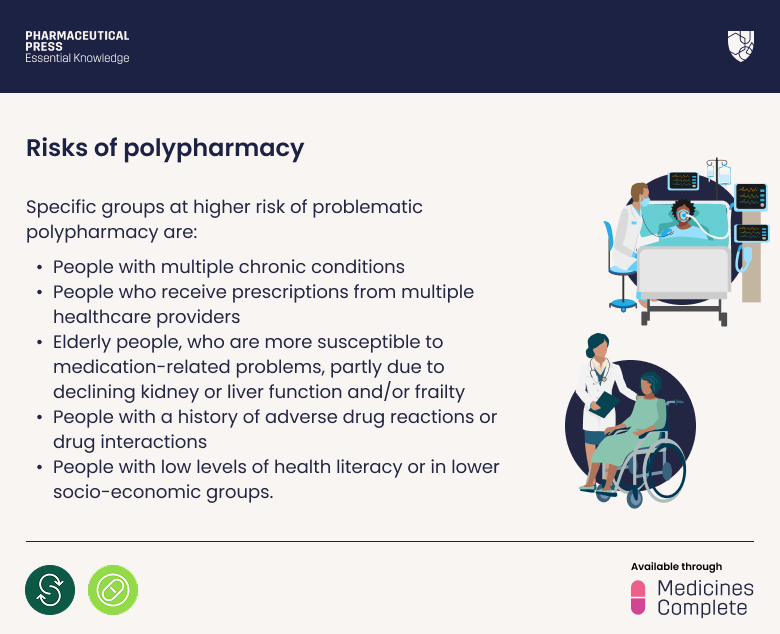What is polypharmacy?
Polypharmacy means “many medications” and the term is used when people are regularly taking multiple medicines.¹ ² ³ Polypharmacy is increasingly common due to factors such as longer life expectancy and the rising proportion of people with multimorbidity, or the coexistence of two or more long-term conditions.
In the UK 8.4 million people are known to regularly take five or more medicines.⁴ In addition, many common conditions now require the use of several classes of drug (e.g. heart failure, secondary prevention of myocardial infarction).
Polypharmacy is therefore often necessary but it can also cause significant harm.⁵ ⁶ Health professionals need a good understanding of the challenges it presents and how to work across sectors to optimise medication regimens.⁷
This article gives an overview of polypharmacy, its consequences, and approaches to manage it in practice.

Please complete the form at the bottom of this article to request a complimentary trial of MedicinesComplete.
When is polypharmacy a problem?
Historically, polypharmacy was defined as the use of five or more medicines but, recognising that patients often need to take multiple medicines to manage their conditions, the ‘pill count’ is now less relevant and instead it is considered to be either appropriate or problematic.¹ ²
• Appropriate polypharmacy is when all the medicines a person is taking are clinically indicated, with expected health benefits, optimised and prescribed according to best evidence.¹
• Problematic polypharmacy is when one or more medicines taken are not needed. This may be for a wide range of reasons, including: no evidence-based indication for the medicine’s use, the medicine is no longer appropriate, the medicine or a combination of medicines causes or risks harm.¹ ³

There is some overlap between problematic polypharmacy and overprescribing. Overprescribing is the use of a medicine when a better, non-pharmacological option is available, or when its use is inappropriate for the person’s circumstances or wishes.¹
Overprescribing incurs an increased risk of adverse drug effects, higher NHS costs, and leads to medication waste.
Polypharmacy is an important contributory factor in medication errors (i.e. a preventable event that leads to inappropriate medication use or patient harm).¹ The inappropriate use of medicines accounts for almost 50% of preventable harm to patients and, in around a quarter of cases, harm can be severe or even life-threatening.¹ ⁸ It also increases the risk of hospital admissions due to adverse drug reactions – as many as one in five hospital admissions in the UK are the result of an adverse drug event – and this in turn leads to higher healthcare costs.⁴ ⁶ ⁷ Polypharmacy also increases the potential for preventable drug-drug interactions.
When people experience troublesome side effects, they become less inclined to take their medication. This can result in suboptimal adherence, and, in turn, poor outcomes.³ Inappropriate polypharmacy can also occur due to ‘prescribing cascade’.³ ⁹ This happens when a new medicine is started to treat the symptoms of an adverse effect caused by another medicine.
For example, a patient prescribed a diuretic for ankle oedema, caused by a calcium channel blocker, but misinterpreted as heart failure. Failure to spot such side effects may result in an unintentional prescribing cascade, exposing the patient to further adverse effects and drug interactions.
With information on ADRs for more than 1600 drugs used internationally, Martindale’s ADR Checker ensures quick decision-making at the point of care.
Who is at risk?
Many common conditions now require the use of several classes of drug and a high proportion of people have multiple health conditions. Specific groups at higher risk of problematic polypharmacy are:¹ ¹ ¹
• People with multiple chronic conditions
• People who receive prescriptions from multiple healthcare providers
• Elderly people, who are more susceptible to medication-related problems, partly due to declining kidney or liver function and/or frailty
• People with a history of adverse drug reactions or drug interactions
• People with low levels of health literacy or in lower socio-economic groups.
The impact of inappropriate polypharmacy can often be overlooked in older people. Common symptoms due to side effects and drug-drug interactions, such as tiredness, decreased alertness, constipation, diarrhoea, incontinence, loss of appetite, confusion, falls, depression, or a lack of interest in usual activities, can be confused with the signs of normal ageing. Such issues may be ignored or lead to further prescribing i.e. prescription cascade.³
Managing polypharmacy in practice
Managing inappropriate polypharmacy with a personalised approach and shared decision making is vital.¹ ² ⁴ NHS England has identified problematic polypharmacy as a key medicines optimisation priority for 2024/25.¹² Understanding the patient’s experience, making evidence-based medicine choices, ensuring safe medicines use, and embedding medicines optimisation into routine practice, are the key principles.² Various instruments have been developed that can assist the medicines optimisation process, which can be divided into three categories: screening tools, risk scores, and deprescribing guides.⁷ Raising patient awareness about the problems of polypharmacy and non-adherence is also important, as patients can play a key role in the prevention and early detection of inappropriate polypharmacy.¹³
A 2025 report from the Health Innovation Network, described structured medication reviews (SMR) as “the best tested intervention for reducing problematic polypharmacy”.¹⁴ Since October 2020, the NHS has required primary care networks (PCNs) to identify all patients who may benefit from a structured medication review. They include people in care homes, and those who take ten or more medications.¹²
During a structured medication review, health professionals work with patients to review their medicines, taking all aspects of health into account. This involves obtaining an accurate list of medications, (including prescribed medicines, medicines bought over the counter, as well as supplements, herbal and other products), assigning each an indication for use, assessing adherence and identifying adverse reactions and drug–drug interactions.⁷ After this review medication can be targeted for deprescribing, substitution, or dose modification. These sessions, which are typically pharmacist-led, can decrease the number of problematic or unnecessary medicines a person takes by up to 10%.¹² ¹⁴
Polypharmacy is common, and although it is often appropriate and clinically necessary, it is also frequently problematic.
Problematic polypharmacy increases the risk of medication errors, adverse drug events, and poor adherence, and leads to medicines waste. Older people are particularly vulnerable, due to multiple health conditions and age-related changes in drug metabolism.
Medicines can be inappropriate for a wide range of reasons. Medicines optimisation through an evidence-based approach with shared decision-making can support individualised care. Structured medication reviews can help ensure people take only the medicines they need, and that the benefits of treatment outweigh the risks.
Trial form
Please complete the form below to request a complimentary trial to knowledge products through MedicinesComplete.
References
1. NHS Specialist Prescriber Network. (2025). Understanding polypharmacy, overprescribing and deprescribing. Available at: https://www.sps.nhs.uk/articles/understanding-polypharmacy- overprescribing-and-deprescribing/ Last accessed: 24th July 2025.
2. WHO. (2023). Medication without harm. Available at:
https://iris.who.int/bitstream/handle/10665/376212/9789240062764-eng.pdf Last accessed: 24 July 2025.
3. Woodford HJ. Polypharmacy in Older Patients. Br J Hosp Med (Lond). 2024 Oct 30;85(10):1-12. doi: 10.12968/hmed.2024.0388. Epub 2024 Oct 14. PMID: 39475037.
4. Department of Health and Social Care. (2021). Good for you, good for us, good for
everybody: A plan to reduce overprescribing to make patient care better and safer, support the NHS, and reduce carbon emissions. Available at: https://assets.publishing.service.gov.uk/media/614a10fed3bf7f05ab786551/good-for-you-good-for-us-good-for-everybody.pdf Last accessed: 24th July 2025.
5. Payne, R. A., Abel, G. A., et al. (2014). Is polypharmacy always hazardous? A retrospective cohort analysis using linked electronic health records from primary and secondary care. British journal of clinical pharmacology, 77(6), 1073-1082.
6. Osanlou R, Walker L, Hughes DA, Burnside G, Pirmohamed M. Adverse drug reactions, multimorbidity and polypharmacy: a prospective analysis of 1 month of medical
admissions. BMJ Open. . 2022;12(7):e055551. doi:10.1136/bmjopen-2021-055551.
7. Walker LE, Pirmohamed M. Increasing trend in hospitalisation due to adverse drug reactions: can we stem the tide? Drug and Therapeutics Bulletin 2023;61:87-91.
8. Aronson, J. K. (2009). Medication errors: what they are, how they happen, and how to avoid them. QJM: An International Journal of Medicine, 102(8), 513-521.
9. Varghese, D., Ishida, C., et al. (2024). Polypharmacy. StatPearls [Internet]. Available at:
https://www.ncbi.nlm.nih.gov/books/NBK532953/ Last accessed: 24th July 2025.
10. NHS England. (2024). National medicines optimisation opportunities 2024/25. Available at:
https://www.england.nhs.uk/long-read/national-medicines-optimisation-opportunities-2023-24/#1-addressing-problematic-polypharmacy Last accessed: 24th July 2025.
11. Shaikh A, Managing and reducing polypharmacy when prescribing. Pharmaceutical Journal 26th July 2024 pharmaceutical-journal.com-Managing and reducing polypharmacy when prescribing.pdf Last accessed: 8th August 2025.
12. NHS England. (n.d.) Structured medication reviews and medicines optimisation. Available at: https://www.england.nhs.uk/primary-care/pharmacy/smr/ Last accessed: 24th July 2025.
13. Medication Safety in Polypharmacy. Geneva: World Health Organization; 2019 (WHO/UHC/SDS/2019.11). Licence: CC BY-NC-SA 3.0 IGO.Polypharmacy9.
14. Health Innovation Network. (2025). Improving access to Structured Medication Reviews in seldom-heard communities. Available at: https://cdn.thehealthinnovationnetwork.co.uk/wpcontent/uploads/2025/06/Polypharmacy-report-Improving-access-to-SMRs-in-seldom-heard-communities-WEB-2.pdf Last accessed: 24th July 2025.













